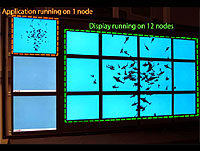SAGE: the Scalable Adaptive Graphics Environment
September 23rd, 2004
Categories: Applications

Authors
Renambot, L., Rao, A., Singh, R., Jeong, B., Krishnaprasad, N., Vishwanath, V., Chandrasekhar, V., Schwarz, N., Spale, A., Zhang, C., Goldman, G., Leigh, J., Johnson, A.About
We envision situation-rooms and research laboratories in which all the walls are made from seamless ultra-high-resolution displays fed by data streamed over ultra-high-speed networks, from distantly located visualization and storage servers. It will allow local and distributed groups of researchers to work together on large amounts of distributed heterogeneous datasets.
From our prior work on the Continuum, we have learned that it is crucial for collaborators to have both local control (e.g. on a tablet or laptop) and the casual ability to share their work and see what others are working on (e.g. on a large tile display). We are taking the next steps toward this vision by building LambdaVision - an 11x5 tiled display with a total resolution of 100 megapixels and developing SAGE, the Scalable Adaptive Graphics Environment.
SAGE will allow the seamless display of various networked applications over the whole display. Each visualization application (such as 3D rendering, remote desktop, video streams, 2D maps) streams its rendered pixels (or primitives) to a virtual high-resolution frame buffer, allowing for any given layout onto the display.
Computing platforms typically provide some notion of remote desktop access. Tools such as VNC or Microsoft’s Remote Desktop were designed to transmit screens of single desktops to remote computers over slow networks. They are designed to operate on event triggered streaming mechanisms that are not suitable for real-time streaming of scientific visualization or collaborative applications. Flexible scalable graphics systems such as Chromium and Aura are designed for distributing visualization to and from cluster driven tiled-displays. Applications have to be specifically written with the Aura API to enable them to transmit their graphics and Chromium was not designed to stream graphics over wide-area networks.
IBM’s Scalable Graphics Engine is also a hardware-based approach that allows for reception of pixels streamed over networks and can drive an array of displays synchronously. Currently, it is limited to a 16-port output and does not support protocols for streaming over wide-area networks. In all these approaches, it is difficult for users to add their own video sources, compression modules or network protocols to the systems, which are neededfor high bandwidth wide-area networks.
Resources
Citation
Renambot, L., Rao, A., Singh, R., Jeong, B., Krishnaprasad, N., Vishwanath, V., Chandrasekhar, V., Schwarz, N., Spale, A., Zhang, C., Goldman, G., Leigh, J., Johnson, A., SAGE: the Scalable Adaptive Graphics Environment, Proceedings of WACE 2004, September 23rd, 2004.